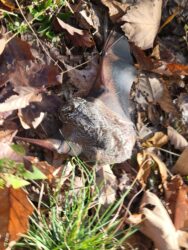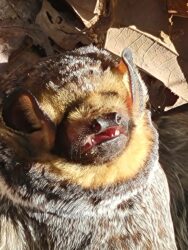I was walking along a ridgetop during my lunch break ; the remaining leaves on the brink of falling from their trees. As I hopped over a fallen log, I heard a shrill hiss. I was immediately worried I had just trampled something, so I stepped back. A fuzzy mass rested in the middle of path, among the chestnut oak leaves. When I stepped forward once more, the critter flung itself on its back and revealed its identity with the spread of its leathery wings and another hiss.
; the remaining leaves on the brink of falling from their trees. As I hopped over a fallen log, I heard a shrill hiss. I was immediately worried I had just trampled something, so I stepped back. A fuzzy mass rested in the middle of path, among the chestnut oak leaves. When I stepped forward once more, the critter flung itself on its back and revealed its identity with the spread of its leathery wings and another hiss.
My present company was a hoary bat (Lasiurus cinereus). He had brown fur frosted with silver, hence the name. His face was scrunched up in a peculiarly permanent frown, framed by yellowish brown fur, which concealed his eyes. Each impressive ear was as large as his face. His wings were spread out and curved inward at each end , translucent in the autumn sunlight. As I safely inspected him to check for injury (there were none) he leapt up and flew away, presumably to find a less bothersome resting spot.
, translucent in the autumn sunlight. As I safely inspected him to check for injury (there were none) he leapt up and flew away, presumably to find a less bothersome resting spot.
Hoary bats are insectivores, most often preying on moths at night, and they must eat a great deal to keep up with their higher energy demands. During the day, they sleep. Hoary bats are known for roosting in trees or in foliage, not often seen by people. While most of our bat species here at Bernheim either torpor or hibernate during the colder months of the year, hoary bats do something out of the ordinary.
Seasonal migration is not as common among Bernheim’s mammals as it is among birds or insects. However, the hoary bat is one who stands out as a migratory mammal. During the warmer seasons, the hoary bat resides in the more northern areas of the Americas – eve n as far as Canada. When the seasons begin to change and the temperature lowers, they make the journey south. Some migrate as far south as South America. Then they depart back to the north when the time comes. Wherever they go, they tend to stick to forests.
n as far as Canada. When the seasons begin to change and the temperature lowers, they make the journey south. Some migrate as far south as South America. Then they depart back to the north when the time comes. Wherever they go, they tend to stick to forests.
Bernheim has a great variety of quality habitats and forest types. The forest is not only great for our year-round native species like the eastern screech owl and the marbled salamander, but it is wonderfully inviting for migrating species like the eastern golden eagle and the hoary bat. Whether as a permanent home, a migration destination, or a stopping point on the way, this forest acts as a safe haven for so many species.

